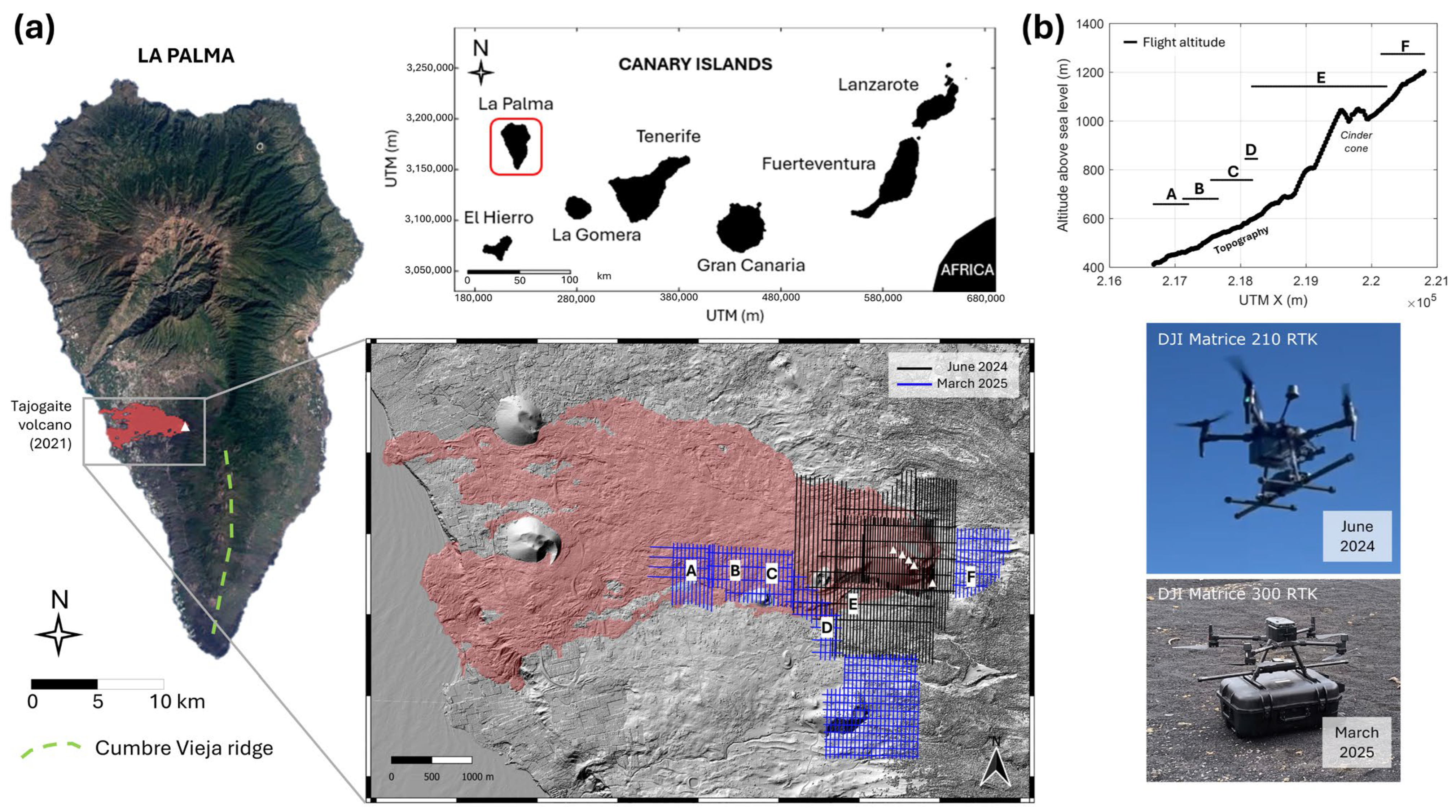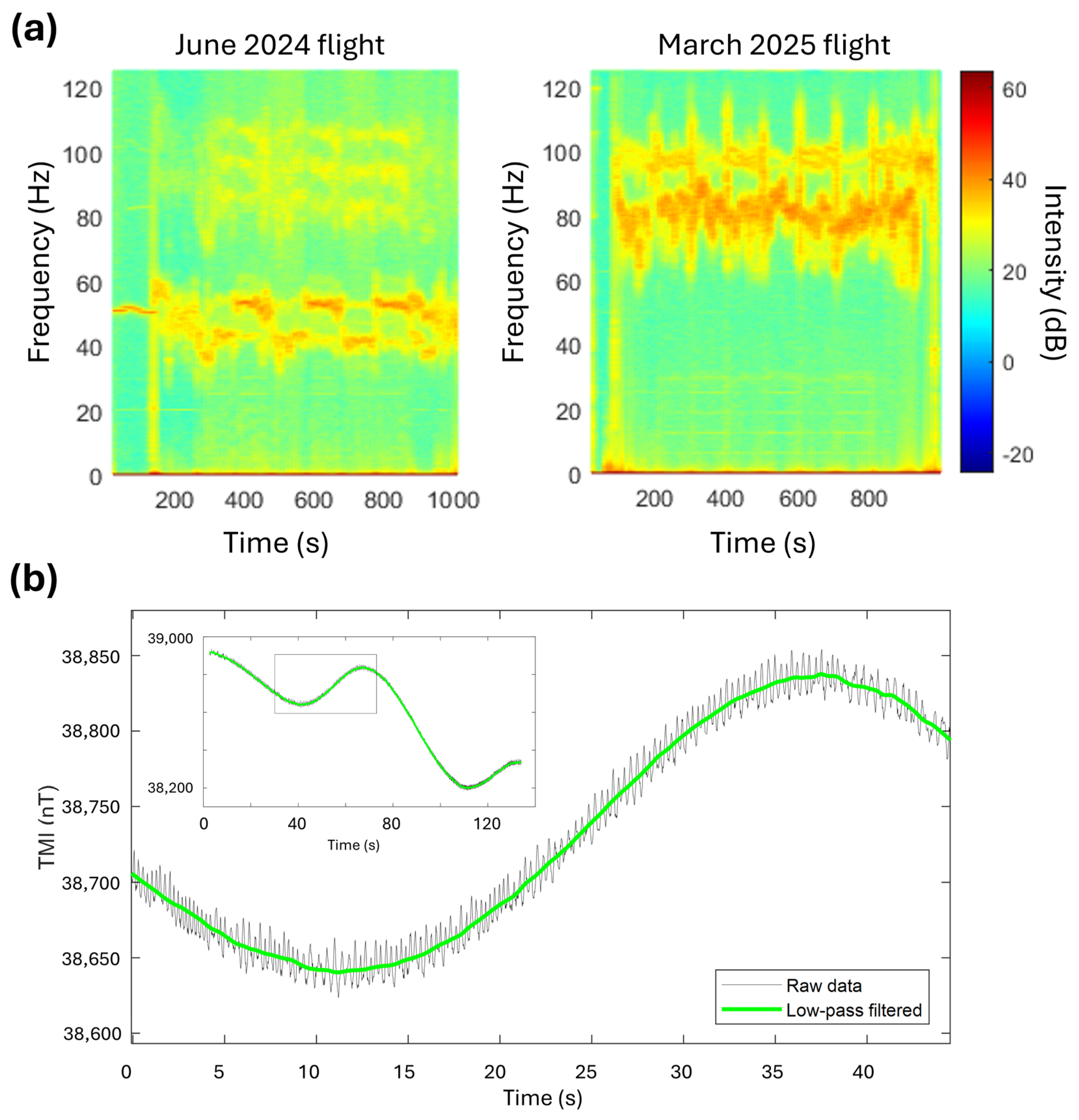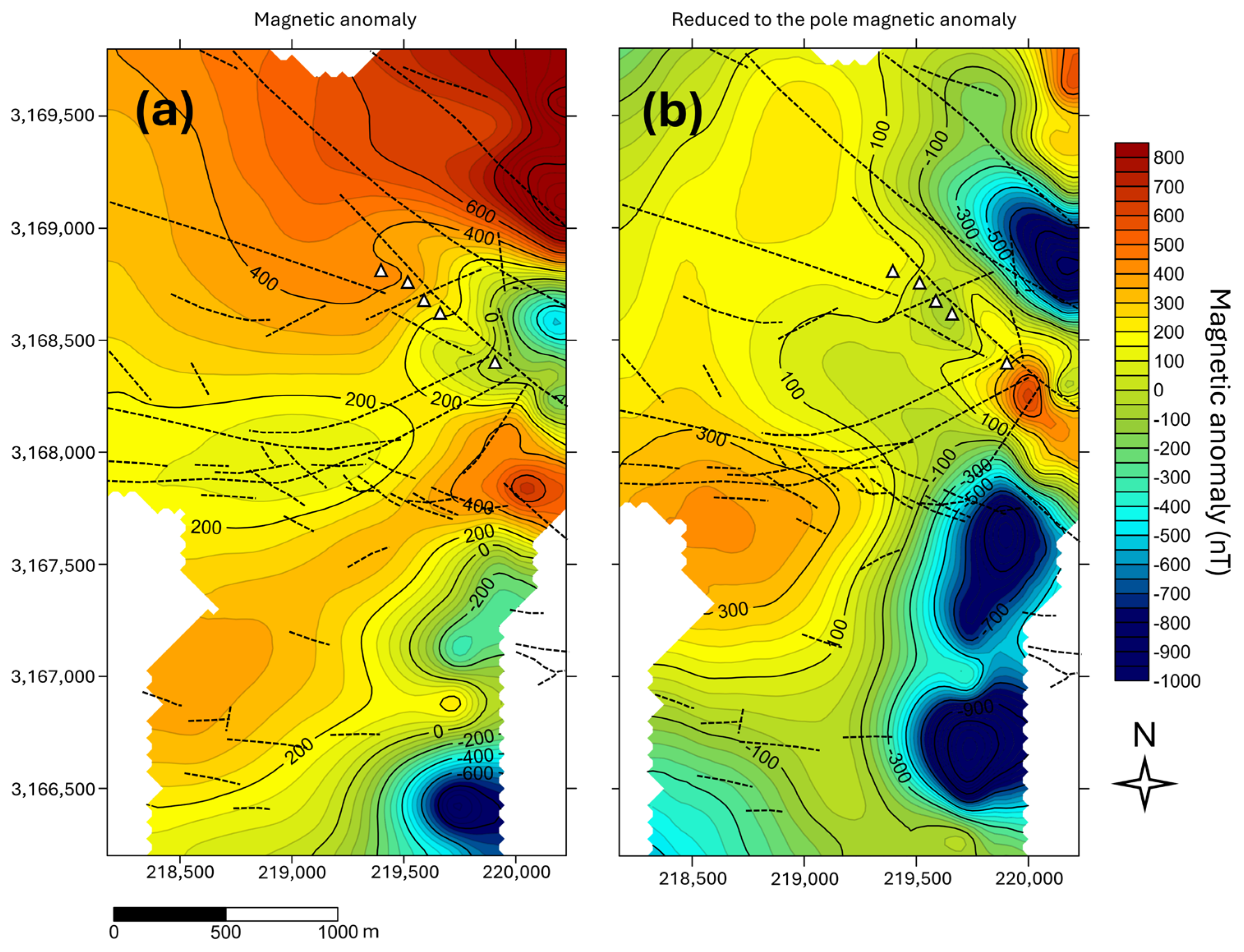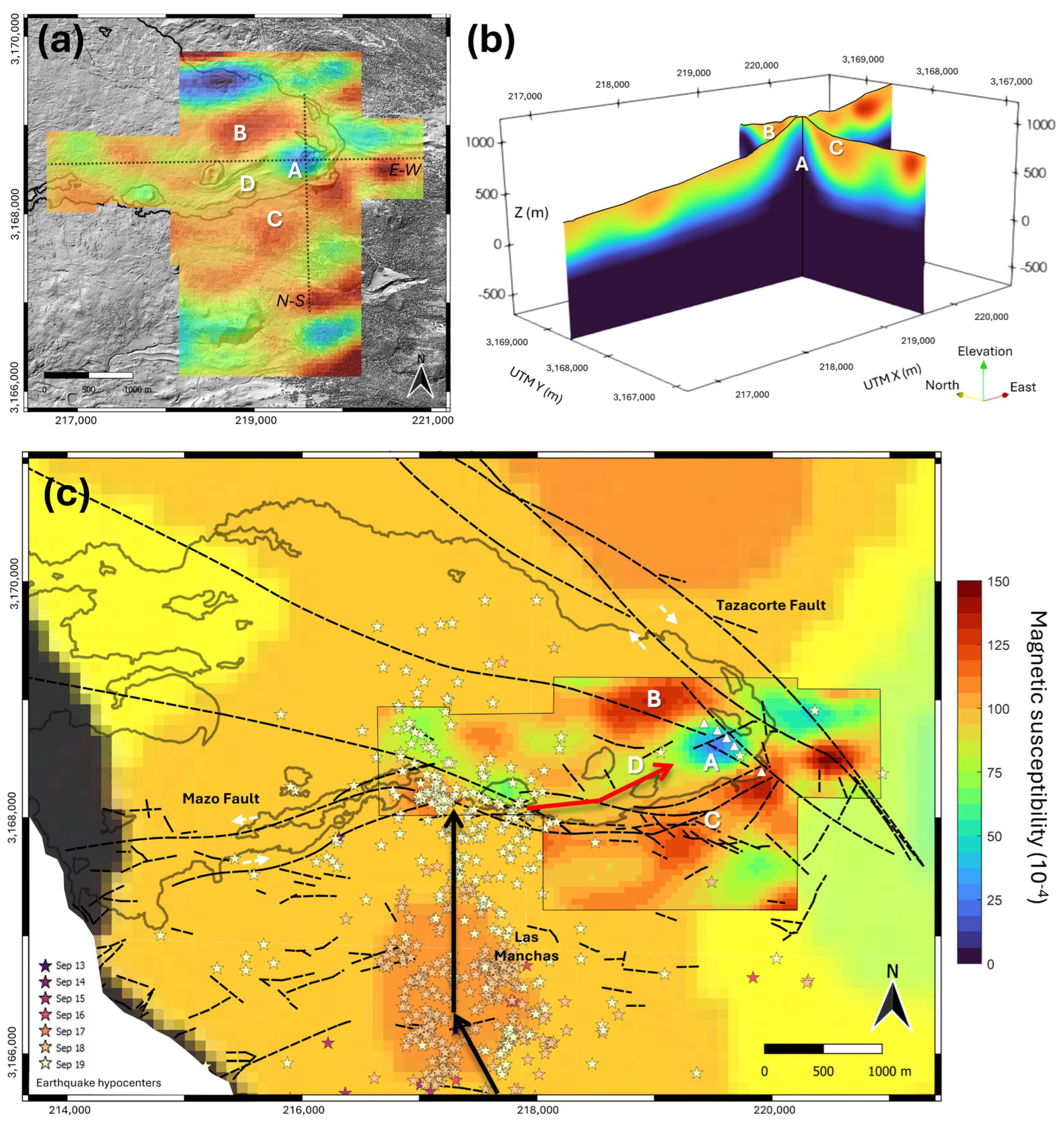High-Resolution Drone-Based Aeromagnetic Survey at the Tajogaite Volcano (La Palma, Canary Islands): Insights into Its Early Post-Eruptive Shallow Structure
Abstract
1. Introduction
2. The Tajogaite Eruption

3. Data and Methods
3.1. Drone Survey
3.2. Corrections on Magnetic Data
3.3. Magnetic Inversion
4. Results
4.1. Magnetic Anomalies at the Tajogaite Volcano
4.2. Magnetic Susceptibility at the Tajogaite Volcano
5. Discussion
5.1. Methodological Lessons on Drone Magnetometry over the Tajogaite Volcano
5.2. Considerations into the Magnetic Modelling
5.3. Magnetic Signature of the Tajogaite Eruption
6. Conclusions
Supplementary Materials
Author Contributions
Funding
Data Availability Statement
Acknowledgments
Conflicts of Interest
Abbreviations
| PEVOLCA | Plan de Emergencias Volcánicas de Canarias |
| DInSAR | Diferential Interferometric Synthetic Aperture Radar |
| DSM | Digital Surface Model |
| TMI | Total Magnetic Intensity |
| STFT | Short-Time Fourier Transform |
| LiDAR | Light Detection and Ranging |
| IGN | Institute Geográfico Nacional (Spanish National Geographic Institute) |
| RTP | Reduction to the Pole |
| IGRF | International Geomagnetic Reference Field |
References
- Mezcua, J.; Rueda, J. Seismic velocity variations observed prior to the La Palma volcano eruption on 19 September 2021, in Cumbre Vieja, Canary Islands (Spain). Seism. Rec. 2024, 4, 11–20. [Google Scholar] [CrossRef]
- Torres-González, P.A.; Luengo-Oroz, N.; Lamolda, H.; D’Alessandro, W.; Albert, H.; Iribarren, I.; Moure-García, D.; Soler, V. Unrest signals after 46 years of quiescence at cumbre vieja, la palma, Canary Islands. J. Volcanol. Geotherm. Res. 2020, 392, 106757. [Google Scholar] [CrossRef]
- Bonadonna, C.; Pistolesi, M.; Biass, S.; Voloschina, M.; Romero, J.; Coppola, D.; Folch, A.; D’Auria, L.; Martin-Lorenzo, A.; Dominguez, L. Physical characterization of long-lasting hybrid eruptions: The 2021 Tajogaite eruption of Cumbre Vieja (La Palma, Canary Islands). J. Geophys. Res. Solid Earth 2022, 127, e2022JB025302. [Google Scholar] [CrossRef]
- Piña-Varas, P.; Ledo, J.; Queralt, P.; van Dorth, D.M.; Marcuello, A.; Cabrera-Pérez, I.; D’Auria, L.; Martí, A. Volcanic monitoring of the 2021 La Palma eruption using long-period magnetotelluric data. Sci. Rep. 2023, 13, 15929. [Google Scholar] [CrossRef]
- Blanco-Montenegro, I.; Arnoso, J.; Sánchez, N.; Montesinos, F.G.; Gómez-Ortiz, D.; Nicolosi, I.; Vélez, E.; Benavent, M. Volcanomagnetic signals related to the 2021 Tajogaite volcanic eruption in the Cumbre Vieja rift (La Palma, Canary Islands). J. Volcanol. Geotherm. Res. 2024, 455, 108200. [Google Scholar] [CrossRef]
- Del Fresno, C.; Cesca, S.; Klügel, A.; Domínguez Cerdeña, I.; Díaz-Suárez, E.A.; Dahm, T.; García-Cañada, L.; Meletlidis, S.; Milkereit, C.; Valenzuela-Malebrán, C. Magmatic plumbing and dynamic evolution of the 2021 La Palma eruption. Nat. Commun. 2023, 14, 358. [Google Scholar] [CrossRef]
- Benito, M.; Alvarado, G.; Marchamalo, M.; Rejas, J.; Murphy, P.; Franco, R.; Castro, D.; Garcia-Lanchares, C.; Sanchez, J. Temporal and spatial evolution of the 2021 eruption in the Tajogaite volcano (Cumbre Vieja rift zone, La Palma, Canary Islands) from geophysical and geodetic parameter analyses. Nat. Hazards 2023, 118, 2245–2284. [Google Scholar] [CrossRef]
- Hernandez-Pacheco, A.; Valls, M. The historic eruptions of La Palma island (Canaries). Arquipél. Sér. Ciênc. Nat. 1982, 3, 83–94. [Google Scholar]
- Alcázar-Treviño, J.; Lara, G.; Suarez, E.D.; Bou, M.; Domínguez, I.; Buchan, S.; Domínguez, F.; Fraile-Nuez, E. Hydroacoustic sensing of seismic events during the Tajogaite volcanic eruption (La Palma, Spain). Sci. Rep. 2025, 15, 4137. [Google Scholar] [CrossRef]
- Fernández, J.; Escayo, J.; Hu, Z.; Camacho, A.G.; Samsonov, S.V.; Prieto, J.F.; Tiampo, K.F.; Palano, M.; Mallorquí, J.J.; Ancochea, E. Detection of volcanic unrest onset in La Palma, Canary Islands, evolution and implications. Sci. Rep. 2021, 11, 2540. [Google Scholar] [CrossRef]
- Fernández, J.; Escayo, J.; Prieto, J.F.; Tiampo, K.F.; Camacho, A.G.; Ancochea, E. Volcanic unrest after the 2021 eruption of La Palma. Geophys. Res. Lett. 2024, 51, e2024GL108803. [Google Scholar] [CrossRef]
- Fabbrizio, A.; Bamber, E.C.; Michailidou, E.; Romero, J.E.; Arzilli, F.; Bonechi, B.; Polacci, M.; Burton, M. Phase equilibrium experiments and thermodynamic simulations to constrain the pre-eruptive conditions of the 2021 Tajogaite eruption (Cumbre Vieja volcano, La Palma, Canary Islands). J. Volcanol. Geotherm. Res. 2023, 442, 107901. [Google Scholar] [CrossRef]
- Andújar, J.; Scaillet, B.; Frascerra, D.; Di Carlo, I.; Casillas, R.; Suárez, E.; Domínguez-Cerdeña, I.; Meletlidis, S.; López, C.; Slodczyk, A. Evolution of the crustal reservoir feeding La Palma 2021 eruption. Insights from phase equilibrium experiments and petrologically derived time scales. J. Volcanol. Geotherm. Res. 2025, 463, 108327. [Google Scholar] [CrossRef]
- Da Mommio, S.; Voloschina, M.; Coldwell, B.C.; Pérez, N.M.; Bonadonna, C.; Pistolesi, M. Eruptive dynamics of the 2021 Tajogaite eruption (La Palma, Canary Islands) as revealed by the physical and textural characterization of tephra. Bull. Volcanol. 2025, 87, 43. [Google Scholar] [CrossRef]
- Biagioli, E.; La Spina, G.; Polacci, M.; Bonechi, B.; Romero, J.E.; Burton, M. Numerical modeling integrated with field observations and analytical data of the 2021 Cumbre Vieja eruption improves understanding of eruption dynamics at mafic volcanoes. J. Geophys. Res. Solid Earth 2025, 130, e2024JB029692. [Google Scholar] [CrossRef]
- Hinze, W.J.; Von Frese, R.R.; Von Frese, R.; Saad, A.H. Gravity and Magnetic Exploration: Principles, Practices, and Applications; Cambridge University Press: Cambridge, UK, 2013. [Google Scholar]
- Barone, A.; Milano, M.; Fedi, M. Inhomogeneous magnetization of Tyrrhenian seamounts revealed from gravity and magnetic correlation analysis. J. Geophys. Res. Solid Earth 2024, 129, e2024JB028977. [Google Scholar] [CrossRef]
- Caracciolo, F.A.; Nicolosi, I.; Carluccio, R.; Chiappini, S.; De Ritis, R.; Giuntini, A.; Materni, V.; Messina, A.; Chiappini, M. High resolution aeromagnetic anomaly map of Mount Etna volcano, Southern Italy. J. Volcanol. Geotherm. Res. 2014, 277, 36–40. [Google Scholar] [CrossRef]
- De Ritis, R.; Chiappini, M. High resolution magnetic anomalies, volcanism and tectonics of the active “La Fossa” vulcanic system (Vulcano island) and Lipari Island (South Italy). J. Volcanol. Geotherm. Res. 2023, 438, 107823. [Google Scholar] [CrossRef]
- Okuma, S.; Stotter, C.; Supper, R.; Nakatsuka, T.; Furukawa, R.; Motschka, K. Aeromagnetic constraints on the subsurface structure of Stromboli Volcano, Aeolian Islands, Italy. Tectonophysics 2009, 478, 19–33. [Google Scholar] [CrossRef]
- González-de-Vallejo, L.; Álvarez-Hernández, A.; Ferrer, M.; Lockwood, J.P.; Pérez, N.M.; Hernández, P.A.; Miranda-Hardisson, A.; Rodríguez-Losada, J.A.; Afonso-Falcón, D.; de-los-Ríos, H. La Palma 2021 Eruption (Canary Islands): Measurements and Modelling of Lava Flow Cooling Rates and Applications for Infrastructure Reconstruction and Risk Mitigation. GeoHazards 2024, 5, 1093–1124. [Google Scholar] [CrossRef]
- Mercogliano, F.; Barone, A.; Esposito, G.; Accomando, F.; Vitale, A.; Gennarelli, G.; Castaldo, R.; Tizzani, P.; Catapano, I. ITINERIS Geophysical Technologies@ CNR-IREA: Drone-Based Tests at Altopiano di Verteglia, Avellino (Southern Italy). In Proceedings of the International Conference on Computational Science and Its Applications, Istanbul, Turkey, 30 June–3 July 2025; pp. 373–383. [Google Scholar]
- Gailler, L.; Labazuy, P.; Régis, E.; Bontemps, M.; Souriot, T.; Bacques, G.; Carton, B. Validation of a new UAV magnetic prospecting tool for volcano monitoring and geohazard assessment. Remote Sens. 2021, 13, 894. [Google Scholar] [CrossRef]
- Accomando, F.; Bonfante, A.; Buonanno, M.; Natale, J.; Vitale, S.; Florio, G. The drone-borne magnetic survey as the optimal strategy for high-resolution investigations in presence of extremely rough terrains: The case study of the Taverna San Felice quarry dike. J. Appl. Geophys. 2023, 217, 105186. [Google Scholar] [CrossRef]
- James, M.R.; Carr, B.; D’Arcy, F.; Diefenbach, A.; Dietterich, H.; Fornaciai, A.; Lev, E.; Liu, E.; Pieri, D.; Rodgers, M. Volcanological applications of unoccupied aircraft systems (UAS): Developments, strategies, and future challenges. Volcanica 2020, 3, 67–114. [Google Scholar] [CrossRef]
- Carracedo, J.C.; Badiola, E.R.; Guillou, H.; de la Nuez, J.; Pérez Torrado, F.J. Geology and volcanology of La Palma and El Hierro, Western Canaries. Estud. Geol. 2001, 57, 175–273. [Google Scholar] [CrossRef]
- Muñoz, V.; Walter, T.R.; Zorn, E.U.; Shevchenko, A.V.; González, P.J.; Reale, D.; Sansosti, E. Satellite radar and camera time series reveal transition from aligned to distributed crater arrangement during the 2021 eruption of Cumbre Vieja, La Palma (Spain). Remote Sens. 2022, 14, 6168. [Google Scholar] [CrossRef]
- Civico, R.; Ricci, T.; Scarlato, P.; Taddeucci, J.; Andronico, D.; Del Bello, E.; D’Auria, L.; Hernández, P.A.; Pérez, N.M. High-resolution digital surface model of the 2021 eruption deposit of Cumbre Vieja volcano, La Palma, Spain. Sci. Data 2022, 9, 435. [Google Scholar] [CrossRef]
- Pankhurst, M.J.; Scarrow, J.H.; Barbee, O.A.; Hickey, J.; Coldwell, B.C.; Rollinson, G.K.; Rodríguez-Losada, J.A.; Lorenzo, A.M.; Rodríguez, F.; Hernández, W. Rapid response petrology for the opening eruptive phase of the 2021 Cumbre Vieja eruption, La Palma, Canary Islands. Volcanica 2022, 5, 1–10. [Google Scholar] [CrossRef]
- Parés, J.M.; Vernet, E.; Calvo-Rathert, M.; Soler, V.; Bógalo, M.-F.; Álvaro, A. Rock Magnetism of Lapilli and Lava Flows from Cumbre Vieja Volcano, 2021 Eruption (La Palma, Canary Islands): Initial Reports. Geosciences 2022, 12, 271. [Google Scholar] [CrossRef]
- Calvo-Rathert, M.; Vernet, E.; Parés, J.M.; Soler, V.; Sánchez-Moreno, E.-M.; Bógalo, M.-F.; Carrancho, Á.; Yamamoto, Y.; Rodríguez-Méndez, L. Reliability of the palaeomagnetic signal recorded in a lava flow erupted on 4 December 2021 in La Palma (Canary Islands, Spain). Geophys. J. Int. 2024, 239, 841–861. [Google Scholar] [CrossRef]
- Suarez, E.; Domínguez-Cerdeña, I.; Villaseñor, A.; Aparicio, S.S.-M.; del Fresno, C.; García-Cañada, L. Unveiling the pre-eruptive seismic series of the La Palma 2021 eruption: Insights through a fully automated analysis. J. Volcanol. Geotherm. Res. 2023, 444, 107946. [Google Scholar] [CrossRef]
- Montesinos, F.G.; Sainz-Maza, S.; Gómez-Ortiz, D.; Arnoso, J.; Blanco-Montenegro, I.; Benavent, M.; Vélez, E.; Sánchez, N.; Martín-Crespo, T. Insights into the Magmatic Feeding System of the 2021 Eruption at Cumbre Vieja (La Palma, Canary Islands) Inferred from Gravity Data Modeling. Remote Sens. 2023, 15, 1936. [Google Scholar] [CrossRef]
- Fernández, J.; Escayo, J.; Camacho, A.G.; Palano, M.; Prieto, J.F.; Hu, Z.; Samsonov, S.V.; Tiampo, K.F.; Ancochea, E. Shallow magmatic intrusion evolution below La Palma before and during the 2021 eruption. Sci. Rep. 2022, 12, 20257. [Google Scholar] [CrossRef]
- De Luca, C.; Valerio, E.; Giudicepietro, F.; Macedonio, G.; Casu, F.; Lanari, R. Pre-and Co-Eruptive Analysis of the September 2021 Eruption at Cumbre Vieja Volcano (La Palma, Canary Islands) Through DInSAR Measurements and Analytical Modeling. Geophys. Res. Lett. 2022, 49, e2021GL097293. [Google Scholar] [CrossRef]
- Przeor, M.; Castaldo, R.; D’Auria, L.; Pepe, A.; Pepe, S.; Sagiya, T.; Solaro, G.; Tizzani, P.; Barrancos Martínez, J.; Pérez, N. Geodetic imaging of magma ascent through a bent and twisted dike during the Tajogaite eruption of 2021 (La Palma, Canary Islands). Sci. Rep. 2024, 14, 212. [Google Scholar] [CrossRef] [PubMed]
- Rodríguez-Pascua, M.Á.; Perez-Lopez, R.; Perucha, M.Á.; Sánchez, N.; López-Gutierrez, J.; Mediato, J.F.; Sanz-Mangas, D.; Lozano, G.; Galindo, I.; García-Davalillo, J.C. Active Faults, Kinematics, and Seismotectonic Evolution during Tajogaite Eruption 2021 (La Palma, Canary Islands, Spain). Appl. Sci. 2024, 14, 2745. [Google Scholar] [CrossRef]
- Copernicus Emergency Management Service. Activation EMSR546—La Palma Volcanic Eruption. 2023. Available online: https://mapping.emergency.copernicus.eu/activations/EMSR546/ (accessed on 5 June 2025).
- Accomando, F.; Vitale, A.; Bonfante, A.; Buonanno, M.; Florio, G. Performance of two different flight configurations for drone-borne magnetic data. Sensors 2021, 21, 5736. [Google Scholar] [CrossRef]
- Kaub, L.; Keller, G.; Bouligand, C.; Glen, J.M. Magnetic surveys with Unmanned Aerial Systems: Software for assessing and comparing the accuracy of different sensor systems, suspension designs and compensation methods. Geochem. Geophys. Geosyst. 2021, 22, e2021GC009745. [Google Scholar] [CrossRef]
- Accomando, F.; Florio, G. Applicability of Small and Low-Cost Magnetic Sensors to Geophysical Exploration. Sensors 2024, 24, 7047. [Google Scholar] [CrossRef]
- Walter, C.; Braun, A.; Fotopoulos, G. Characterizing electromagnetic interference signals for unmanned aerial vehicle geophysical surveys. Geophysics 2021, 86, J21–J32. [Google Scholar] [CrossRef]
- International Association of Geomagnetism and Aeronomy. IGRF-14. Zenodo. 2024. Available online: https://zenodo.org/records/14012303 (accessed on 5 June 2025).
- QGIS Team. QGIS Geographic Information System, version 3.40.4; Open Source Geospatial Foundation: Beaverton, OR, USA, 2025.
- Romero-Toribio, M.C.; Martín-Hernández, F.; Ledo, J. The Aeromagnetic Signature of the Tajogaite Volcano on La Palma Island, Canary Archipelago (Abstract AS25-0573). In Proceedings of the IAGA/IASPEI Joint Scientific Meeting 2025, Lisbon, Portugal, 31 August–5 September 2025; Book of Abstracts. CZECH-IN s.r.o.: Prague, Czech Republic, 2025; p. 136. [Google Scholar]
- Magli, A.; Del Carlo, P.; Di Roberto, A.; Giordano, G.; Meletlidis, S.; Pompilio, M.; Speranza, F. Age-clustered eruptive activity at La Palma (Canary Islands) during the last 4000 years: Evidence from paleomagnetic dating. J. Volcanol. Geotherm. Res. 2025, 462, 108328. [Google Scholar] [CrossRef]
- Lopez-Loera, H.; Urrutia-Fucugauchi, J.; Alva-Valdivia, L.M. Magnetic characteristics of fracture zones and constraints on the subsurface structure of the Colima Volcanic Complex, western Mexico. Geosphere 2010, 6, 35–46. [Google Scholar] [CrossRef]
- Dumont, M.; Peltier, A.; Roblin, E.; Reninger, P.-A.; Barde-Cabusson, S.; Finizola, A.; Ferrazzini, V. Imagery of internal structure and destabilization features of active volcano by 3D high resolution airborne electromagnetism. Sci. Rep. 2019, 9, 18280. [Google Scholar] [CrossRef]
- Okuma, S.; Nakatsuka, T.; Ishizuka, Y. Aeromagnetic constraints on the subsurface structure of Usu Volcano, Hokkaido, Japan. Explor. Geophys. 2014, 45, 24–36. [Google Scholar] [CrossRef]
- Dunlop, D.J.; Özdemir, Ö. Rock Magnetism: Fundamentals and Frontiers; Cambridge University Press: Cambridge, UK, 1997. [Google Scholar]
- Biasi, J.; Tivey, M.; Fluegel, B. Volcano monitoring with magnetic measurements: A simulation of eruptions at Axial Seamount, Kīlauea, Bárðarbunga, and Mount Saint Helens. Geophys. Res. Lett. 2022, 49, e2022GL100006. [Google Scholar] [CrossRef]




Disclaimer/Publisher’s Note: The statements, opinions and data contained in all publications are solely those of the individual author(s) and contributor(s) and not of MDPI and/or the editor(s). MDPI and/or the editor(s) disclaim responsibility for any injury to people or property resulting from any ideas, methods, instructions or products referred to in the content. |
© 2025 by the authors. Licensee MDPI, Basel, Switzerland. This article is an open access article distributed under the terms and conditions of the Creative Commons Attribution (CC BY) license (https://creativecommons.org/licenses/by/4.0/).
Share and Cite
Romero-Toribio, M.C.; Martín-Hernández, F.; Ledo, J. High-Resolution Drone-Based Aeromagnetic Survey at the Tajogaite Volcano (La Palma, Canary Islands): Insights into Its Early Post-Eruptive Shallow Structure. Remote Sens. 2025, 17, 3153. https://doi.org/10.3390/rs17183153
Romero-Toribio MC, Martín-Hernández F, Ledo J. High-Resolution Drone-Based Aeromagnetic Survey at the Tajogaite Volcano (La Palma, Canary Islands): Insights into Its Early Post-Eruptive Shallow Structure. Remote Sensing. 2025; 17(18):3153. https://doi.org/10.3390/rs17183153
Chicago/Turabian StyleRomero-Toribio, María C., Fátima Martín-Hernández, and Juanjo Ledo. 2025. "High-Resolution Drone-Based Aeromagnetic Survey at the Tajogaite Volcano (La Palma, Canary Islands): Insights into Its Early Post-Eruptive Shallow Structure" Remote Sensing 17, no. 18: 3153. https://doi.org/10.3390/rs17183153
APA StyleRomero-Toribio, M. C., Martín-Hernández, F., & Ledo, J. (2025). High-Resolution Drone-Based Aeromagnetic Survey at the Tajogaite Volcano (La Palma, Canary Islands): Insights into Its Early Post-Eruptive Shallow Structure. Remote Sensing, 17(18), 3153. https://doi.org/10.3390/rs17183153






